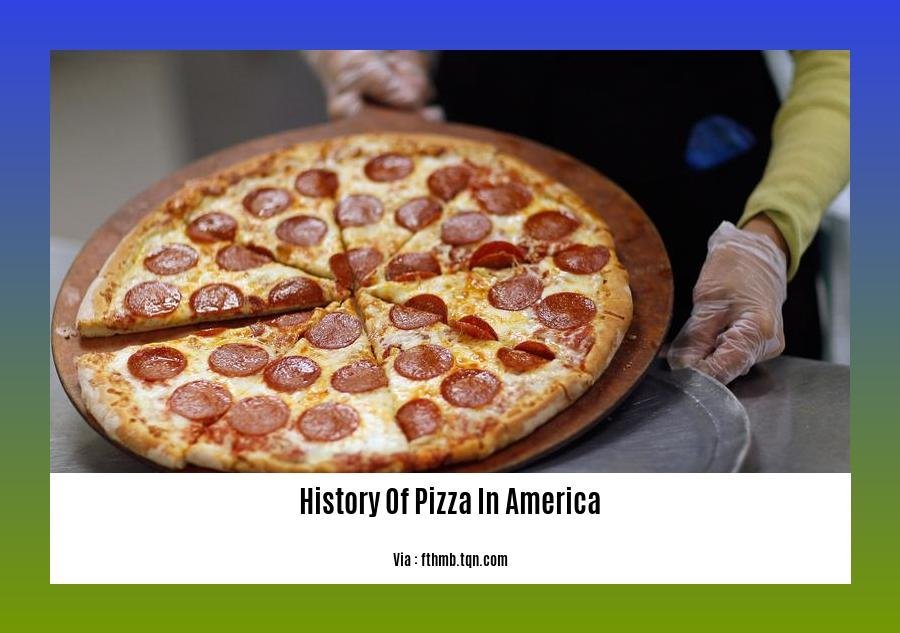Embark on a culinary journey through time as we explore the captivating history of pizza in America. From its humble origins in the bustling streets of Naples to its iconic status as a beloved dish across the nation, pizza has woven its way into the fabric of American food culture. Join us as we delve into the fascinating story of how this simple dish became a symbol of culinary innovation, cultural exchange, and the American dream itself: [Tracing the History of Pizza in America: A Culinary Journey].
Key Takeaways:
Pizza was brought to the United States by Italian immigrants in the early 1900s.
Lombardi’s, the first pizzeria in the US, opened in New York City in 1905.
Pizza’s popularity soared after World War II when soldiers who had tasted it in Italy returned home.
Today, pizza is a beloved fast food in the United States, with many regional variations.
Common toppings for pizza in the US include pepperoni, mushrooms, olives, onions, peppers, sausage, salami, ground beef, bacon, ham, chicken, anchovies, tomatoes, spinach, and pineapple.
History of Pizza in America

Ever wonder how pizza made its way to becoming such a staple food in the United States? Let’s embark on a culinary journey to explore this beloved dish’s unique evolution on American soil.
Humble Beginnings: The Spark of a Culinary Revolution
In the early 1900s, a wave of Italian immigrants brought their cherished culinary traditions to American shores, including the art of pizza making. The first pizzeria in the United States was established in New York City’s bustling Little Italy in 1905. Lombardi’s, founded by Gennaro Lombardi, marked the humble beginning of pizza’s journey to culinary stardom.
Post-War Craze: A Taste of Italy Returns Home
During World War II, American soldiers stationed in Italy returned home with fond memories of the delicious pizza they had tasted. The demand for this delectable dish skyrocketed, and pizzerias began to sprout up across the country. By the 1950s, pizza had cemented its place as a beloved fast food, captivating the taste buds of Americans from coast to coast.
Regional Variations: A Tapestry of Flavors
As pizza’s popularity grew, so did its regional variations. New York-style pizza, known for its thin crust and crispy texture, became an iconic symbol of the city that never sleeps. Chicago-style pizza, with its deep-dish crust and mountain of toppings, offered a hearty and indulgent take on the classic dish. California-style pizza, with its focus on fresh, local ingredients and innovative flavor combinations, reflected the state’s culinary creativity.
Toppings Galore: A Symphony of Flavors
The variety of toppings available on American pizzas is as diverse as the country itself. From classic combinations like pepperoni and cheese or mushrooms and sausage to more adventurous offerings like pineapple and ham or artichoke hearts and roasted red peppers, there’s a topping combination to satisfy every palate.
Pizza Today: An American Icon
Today, pizza is an integral part of American cuisine. Whether you prefer a thin and crispy slice from a New York pizzeria or a deep-dish extravaganza from Chicago, there’s no denying the enduring popularity of this delicious dish. Pizza has become more than just food; it’s a symbol of family, friendship, and celebration, enjoyed by people of all ages and backgrounds.
So, the next time you savor a slice of pizza, take a moment to appreciate its rich history and the culinary journey that brought it to your plate. From its humble beginnings in Naples, Italy, to its iconic status in the United States, pizza has captured the hearts and taste buds of generations, leaving an indelible mark on American cuisine.
Want to know the story behind the taste that tantalizes your taste buds? Dive into the history of oriental cuisine.
The evolution of pizza from a working-class food to a mainstream favorite, driven by factors such as the rise of chain restaurants, the popularity of frozen pizza, and the influence of celebrity chefs.

Pizza’s journey in America has been nothing short of remarkable. Once a humble dish enjoyed by the working class, it has now become a mainstream favorite, cherished by people from all walks of life. Several factors have contributed to this transformation, including the rise of chain restaurants, the popularity of frozen pizza, and the influence of celebrity chefs.
Chain Restaurants:
Chain restaurants like Pizza Hut and Domino’s played a crucial role in popularizing pizza across the country. These establishments offered a consistent taste and experience, making it easier for people to enjoy their favorite dish no matter where they were.
Frozen Pizza:
The invention of frozen pizza in the 1950s was another game-changer. It allowed busy families and individuals to enjoy pizza at home without the hassle of making it from scratch.
Celebrity Chefs:
Celebrity chefs like Julia Child and Mario Batali introduced pizza to a wider audience through their cookbooks and television shows. They demonstrated how versatile and delicious pizza could be, inspiring home cooks to experiment with different flavors and toppings.
Key Takeaways:
Pizza’s popularity in America can be attributed to various factors, including the rise of chain restaurants, the popularity of frozen pizza, and the influence of celebrity chefs.
Chain restaurants like Pizza Hut and Domino’s offered a consistent taste and experience, making pizza more accessible to a wider audience.
The invention of frozen pizza in the 1950s made it possible for people to enjoy pizza at home without the hassle of making it from scratch.
Celebrity chefs like Julia Child and Mario Batali introduced pizza to a wider audience through their cookbooks and television shows, inspiring home cooks to experiment with different flavors and toppings.
Source:
- Foodbeast: The History of Pizza: 10 Facts You Probably Never Knew
- Wikipedia: History of pizza
The emergence of regional variations in pizza, such as the New York-style thin crust, the Chicago deep dish, and the California-style gourmet pizza.
Key Takeaways:
New York-style pizza: Thin crust, traditionally topped with tomato sauce and shredded mozzarella cheese, baked in coal-fired ovens.
Chicago-style deep dish pizza: Thick, doughy crust, filled with cheese, sauce, and toppings, baked in a deep dish.
California-style gourmet pizza: Thin, crispy crust, topped with fresh, high-quality ingredients, often inspired by local cuisine.
New York-style pizza
New York-style pizza is characterized by its thin, crispy crust and tangy tomato sauce. The crust is made from a simple dough that is stretched and tossed by hand, then baked at a high temperature. The sauce is typically made from fresh tomatoes, garlic, and basil. The cheese is usually mozzarella, which is shredded and sprinkled on top of the sauce. New York-style pizza is often served plain, but it can also be topped with a variety of ingredients, such as pepperoni, sausage, mushrooms, and onions.
Chicago deep dish pizza
Chicago-style deep dish pizza is a thick, hearty pizza that is filled with cheese, sauce, and toppings. The crust is made from a cornmeal-based dough that is pressed into a deep dish pan. The sauce is typically made from tomatoes, tomato paste, and spices. The cheese is usually a blend of mozzarella and cheddar cheese. The toppings can vary, but they often include pepperoni, sausage, mushrooms, and onions. Chicago-style deep dish pizza is baked at a high temperature until the crust is golden brown and the cheese is bubbly.
California-style gourmet pizza
California-style gourmet pizza is a thin, crispy pizza that is topped with fresh, high-quality ingredients. The crust is made from a sourdough-based dough that is stretched and tossed by hand. The sauce is typically made from fresh tomatoes, garlic, and olive oil. The cheese is usually mozzarella, but it can also be made with other types of cheese, such as goat cheese or blue cheese. The toppings can vary, but they often include fresh vegetables, grilled meats, and artisan cheeses. California-style gourmet pizza is baked at a high temperature until the crust is crispy and the cheese is melted.
Citations:
- History of Pizza
- Regional Variations of Pizza
The cultural significance of pizza as a symbol of American identity, its role in pop culture, and its enduring appeal to people of all ages and backgrounds.
Pizza is not just a dish but a cultural icon deeply ingrained in American society. Its journey in the United States mirrors the country’s multicultural identity, a testament to its ability to absorb, adapt, and innovate.
The Historical Context
In the late 19th and early 20th centuries, waves of Italian immigrants brought pizza, embodying their heritage, to American shores. These immigrants settled in cities like New York, Chicago, and San Francisco, establishing pizzerias that became community hubs.
Post-World War II, cities like Trenton, NJ, witnessed a transformation driven by suburbanization, the rise of fast food, and changing family dynamics as women entered the workforce. Pizza, with its convenience and affordability, thrived in this evolving landscape.
Pop Culture and Pizza’s Enduring Appeal
Pizza’s popularity soared in the latter half of the 20th century, thanks to its prominent portrayal in pop culture. Movies like “Saturday Night Fever” and television shows like “Happy Days” showcased pizza as a symbol of youth, fun, and camaraderie.
Today, pizza transcends age, cultural, and socioeconomic boundaries. Whether it’s a family gathering, a late-night snack, or a casual get-together, pizza remains a universally beloved dish.
Key Takeaways:
Pizza represents the multicultural essence of America, a testament to its ability to embrace and adapt to diverse culinary influences.
Pizza serves as a powerful symbol of historical themes, including immigration, cultural exchange, and urbanization, which have shaped American society.
The enduring appeal of pizza stems from its versatility, affordability, and ability to transcend cultural and generational divides, making it a beloved dish for people of all ages and backgrounds.
Sources:
- A Slice of History: The Role of Pizza in American Cultural Identity
- A Cultural History of Pizza
FAQ
Q1: How did pizza become popular in the United States?
A1: Pizza gained popularity in the United States after World War II when soldiers stationed in Italy returned home with a taste for the dish.
Q2: When was the first pizzeria in the United States opened?
A2: The first pizzeria in the United States, Lombardi’s, opened in New York City in 1905.
Q3: What is the significance of pizza in the United States?
A3: Pizza is a symbol of America’s multicultural identity. It is a food that is loved by people of all backgrounds and cultures.
Q4: What are some of the regional variations of pizza in the United States?
A4: There are many different regional variations of pizza in the United States. Some of the most popular include New York-style pizza, Chicago-style pizza, and California-style pizza.
Q5: What impact did pizza have on American culture?
A5: Pizza had a major impact on American culture. It became a popular fast food item and was depicted in popular culture, movies, and television shows, helping to shape its identity as a uniquely American dish.
- Unlock 6000+ words beginning with he: A comprehensive analysis - April 20, 2025
- Mastering -al Words: A Complete Guide - April 20, 2025
- Master Scrabble: High-Scoring BAR Words Now - April 20, 2025
















